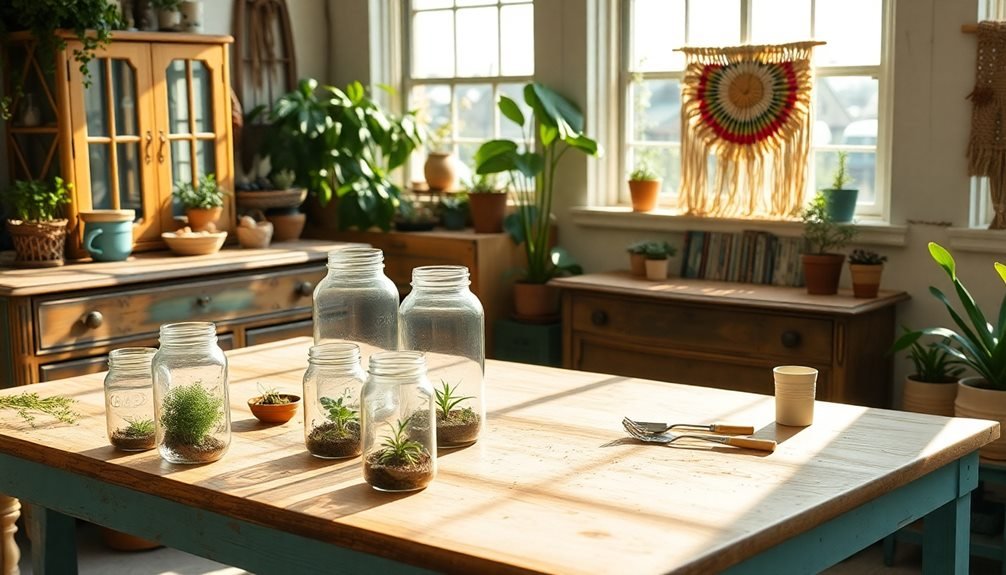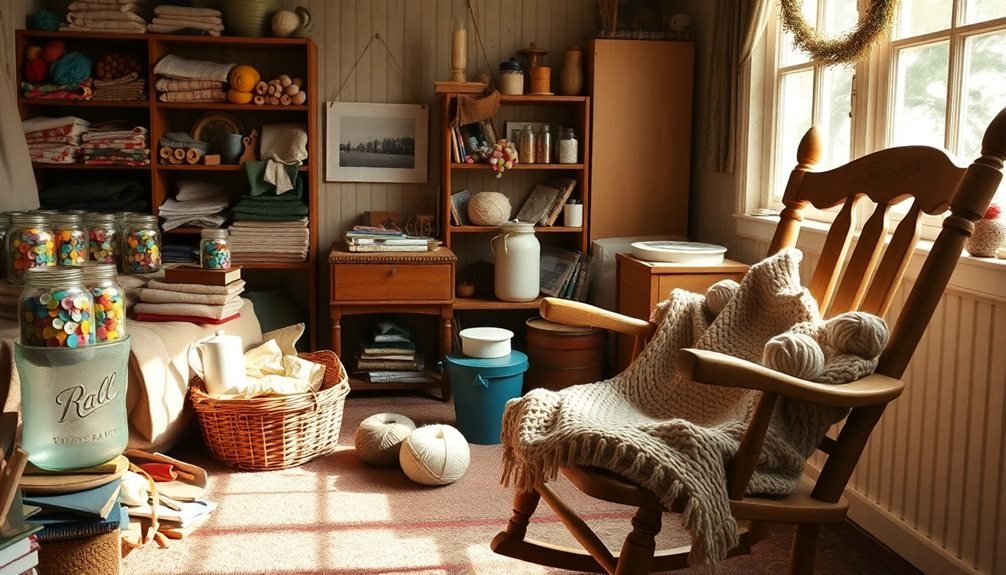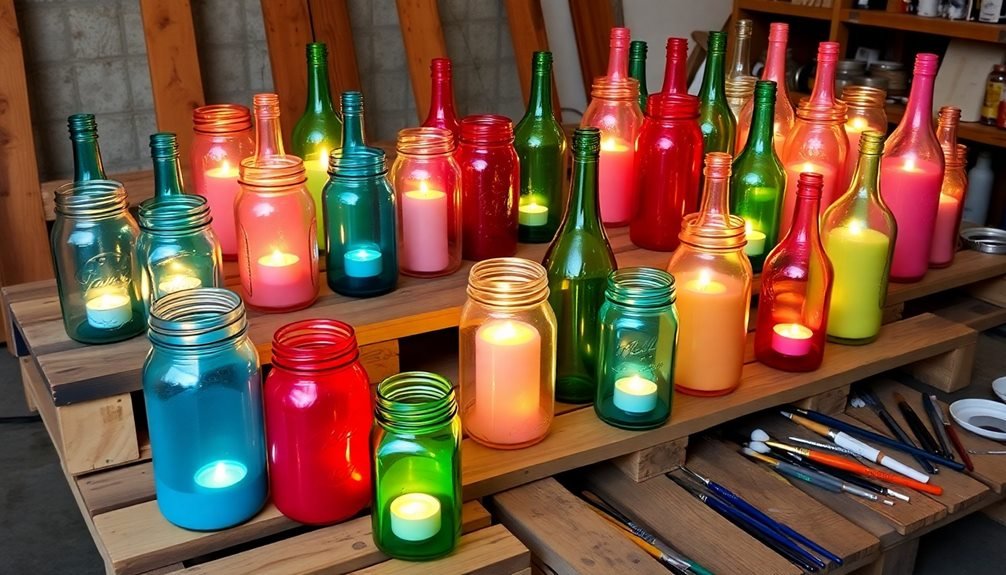You can embrace three enriching upcycling hobbies that combine creativity with mindfulness at home. Transform discarded paper into artistic journals and collages while focusing on textures and sensory experiences. Turn old clothing into woven masterpieces using simple tools and basic techniques to create functional items like coasters and placemats. Restore tired furniture pieces by paying attention to each step of the process, from sanding to finishing, while noticing natural patterns and sounds. These mindful crafting practices won't just reduce waste – they'll help you slow down and connect with your creative spirit in meaningful ways.
Paper Crafting and Journaling

Through creative paper crafting and journaling, you'll transform old cards, magazines, and paper scraps into beautiful works of art while practicing mindfulness.
Start by collecting discarded paper materials and sorting them by color, texture, and size. Create a dedicated crafting space where you can spread out your materials and work without interruption.
Begin with simple projects like collages, where you'll mindfully select and arrange paper pieces to tell a visual story. Turn old magazines into unique journal covers, or craft decorative boxes from greeting cards. As you work, focus on the textures beneath your fingers and the satisfying sound of paper folding.
Transform your paper crafting into a mindfulness practice by maintaining a creative journal. Combine your handwritten thoughts with decorative elements made from upcycled papers.
Try techniques like paper weaving, origami, or quilling to add dimension to your journal pages. Document your creative journey by incorporating paper ephemera from your daily life – ticket stubs, receipts, or packaging can become meaningful artistic elements.
Each time you craft, you're not just creating art; you're giving discarded materials new purpose while staying present in the moment.
Fabric Weaving Projects
Moving from paper to fabric, weaving offers another meditative way to repurpose materials. You can transform old t-shirts, worn-out jeans, and unused bedsheets into stunning textile art pieces. By cutting fabric into strips and using a simple cardboard loom, you'll create unique patterns while practicing mindfulness through repetitive motions.
Start with basic over-under weaving techniques using fabric strips from your old clothes. As you advance, experiment with different materials like ribbon scraps, yarn remnants, or even plastic bags cut into thin strips. You'll need minimal supplies: scissors, a ruler, and a homemade loom from sturdy cardboard or a wooden picture frame.
- Use contrasting colors and textures to create visual interest in wall hangings.
- Weave small, functional items like coasters or placemats for daily use.
- Combine different fabric weights to add depth and dimension to your projects.
Remember to maintain consistent tension as you weave, allowing your mind to focus solely on the rhythmic process. Store your fabric strips in clear containers by color to make selection easier and keep your workspace organized.
Once you've mastered basic techniques, try incorporating beads, buttons, or other found objects into your weaving.
Mindful Furniture Restoration

Anyone can transform old furniture into cherished pieces while practicing mindfulness. Focus your attention on each step of the restoration process, from gentle sanding to the final coat of finish. As you work, you'll discover that furniture restoration isn't just about refinishing – it's about connecting with the piece's history and giving it new life.
| Tool | Mindful Action | Sensory Experience |
|---|---|---|
| Sandpaper | Circular motions | Feel wood grain texture |
| Paint brush | Steady strokes | Watch paint flow smoothly |
| Steel wool | Light buffing | Notice subtle changes |
| Wood oil | Slow application | Smell natural materials |
| Clean cloth | Gentle polishing | See emerging shine |
Start by examining your piece carefully, noting every scratch and dent. Let each imperfection guide your restoration journey. You'll need basic supplies like sandpaper, wood filler, paint or stain, and protective finish. Work in a well-ventilated area where you can spread out your materials. As you restore, pay attention to the wood's natural patterns and how they respond to your touch. Listen to the sounds of sanding, feel the texture changes, and observe how colors deepen with each layer of treatment.
Frequently Asked Questions
How Does Upcycling Impact Mental Health and Stress Reduction?
You'll experience reduced stress and anxiety through upcycling's creative focus. It's a mindful activity that helps you stay present, boosts self-esteem, and gives you a sense of accomplishment when transforming old items.
What Safety Precautions Should Beginners Take When Starting Upcycling Projects?
You'll need protective gear like gloves and goggles, proper ventilation when using chemicals, and a clean workspace. Don't forget to read product labels and keep tools away from children and pets.
Can Upcycling Hobbies Generate Income Through Online Marketplaces?
You can definitely make money selling your upcycled creations on sites like Etsy, eBay, and Facebook Marketplace. If you're consistent with quality and marketing, you'll find buyers who value unique, sustainable items.
Which Upcycling Activities Are Best Suited for Small Living Spaces?
You'll find small-space upcycling perfect with paper crafts, jewelry making, and fabric upcycling. Try converting old books into art, transforming vintage accessories, or creating textile collages right at your desk or table.
How Do I Find Local Upcycling Communities and Workshops Near Me?
You'll find local upcycling groups through Facebook Marketplace, Meetup.com, or NextDoor. Check your library's bulletin board, visit nearby craft stores, and search Instagram hashtags with your city name plus "upcycling" or "repurposing."
In Summary
You've now discovered three ways to transform everyday items into meaningful creations while practicing mindfulness at home. Whether you're giving new life to old papers, weaving discarded fabrics, or restoring vintage furniture pieces, these upcycling hobbies offer both creative satisfaction and environmental benefits. Don't hesitate to start small – even the simplest project can lead to a more sustainable and mindful lifestyle.




Leave a Reply